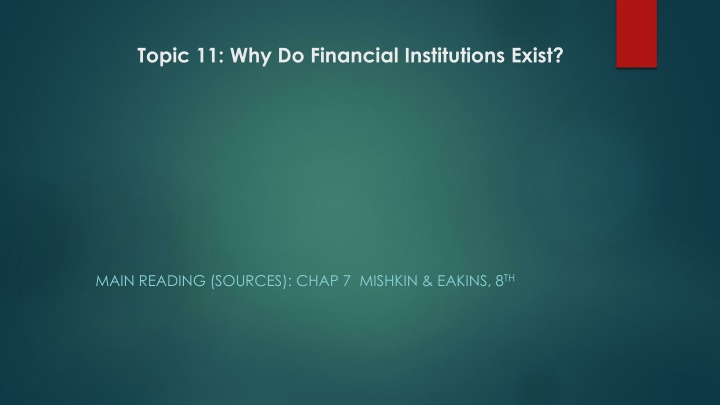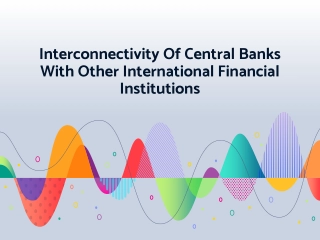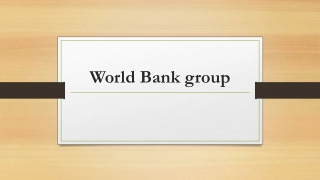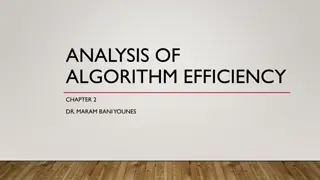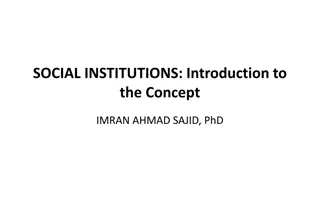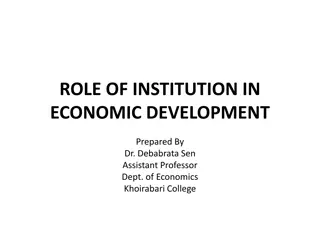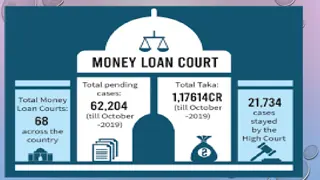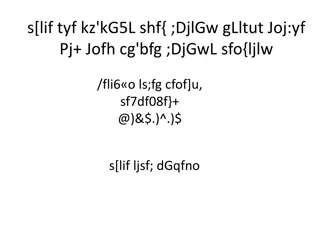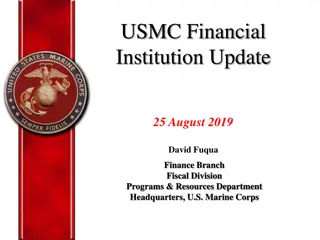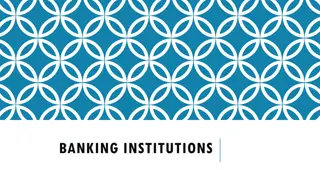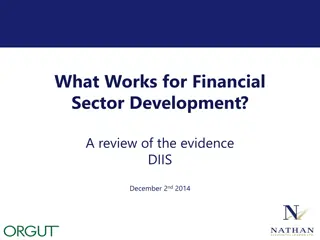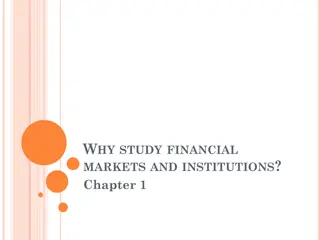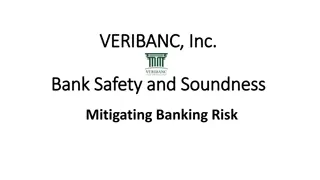Why Financial Institutions Exist and Promote Economic Efficiency
Financial institutions play a crucial role in the economy by facilitating the flow of funds, managing transaction costs, and addressing asymmetric information issues. This chapter explores the importance of financial structure, the role of financial intermediaries, and the impact of regulation on financing mechanisms for businesses.
Download Presentation

Please find below an Image/Link to download the presentation.
The content on the website is provided AS IS for your information and personal use only. It may not be sold, licensed, or shared on other websites without obtaining consent from the author.If you encounter any issues during the download, it is possible that the publisher has removed the file from their server.
You are allowed to download the files provided on this website for personal or commercial use, subject to the condition that they are used lawfully. All files are the property of their respective owners.
The content on the website is provided AS IS for your information and personal use only. It may not be sold, licensed, or shared on other websites without obtaining consent from the author.
E N D
Presentation Transcript
Topic 11: Why Do Financial Institutions Exist? MAIN READING (SOURCES): CHAP 7 MISHKIN & EAKINS, 8TH
Chapter Preview In this chapter, we take a closer look at why financial institutions exist and how they promote economic efficiency. Topics include: Basic Facts About Financial Structure Throughout the World Transaction Costs Asymmetric Information: Adverse Selection and Moral Hazard The Lemons Problem: How Adverse Selection Influences Financial Structure How Moral Hazard Affects the Choice Between Debt and Equity Contracts How Moral Hazard Influences Financial Structure in Debt Markets Conflicts of Interest
Basic Facts About Financial Structure Throughout the World The financial system is a complex structure including many different financial institutions: banks, insurance companies, mutual funds, stock and bonds markets, etc. The chart on the next slide shows how nonfinancial business attain external funding in the U.S., Germany, Japan, and Canada. Notice that, although many aspects of these countries are quite different, the sources of financing are somewhat consistent, with the U.S. being different in its focus on debt.
Figure 7.1 Sources of External Funds for Nonfinancial Businesses: A Comparison of the United States with Germany, Japan, and Canada
Facts of Financial Structure (1 of 2) Stocks are not the most important source of external financing for businesses. Issuing marketable debt and equity securities is not the primary way in which businesses finance their operations. Indirect finance, which involves the activities of financial intermediaries, is many times more important than direct finance, in which businesses raise funds directly from lenders in financial markets. Financial intermediaries, particularly banks, are the most important source of external funds used to finance businesses.
Facts of Financial Structure (2 of 2) The financial system is among the most heavily regulated sectors of economy. Only large, well-established corporations have easy access to securities markets to finance their activities. Collateral is a prevalent feature of debt contracts for both households and businesses. Debt contracts are typically extremely complicated legal documents that place substantial restrictions on the behavior of the borrowers.
Transaction Costs Transactions costs influence financial structure In sum, transactions costs can hinder flow of funds to people with productive investment opportunities Financial intermediaries make profits by reducing transactions costs E.g., a $5,000 investment only allows you to purchase 100 shares @ $50 / share (equity) No diversification Bonds even worse most have a $1,000 size Take advantage of economies of scale (example: mutual funds) Develop expertise to lower transactions costs Also provides investors with liquidity, which explains Fact # 3
Asymmetric Information: Adverse Selection and Moral Hazard Moral Hazard The analysis of how asymmetric information problems affect behavior is known as agency theory. Adverse Selection Occurs when one party has an incentive to behave differently once an agreement is made between parties After transaction occurs Hazard that borrower has incentives to engage in undesirable (immoral) activities making it more likely that won't pay loan back Occurs when one party in a transaction has better information than the other party Before transaction occurs Potential borrowers most likely to produce adverse outcome are ones most likely to seek loan and be selected
The Lemons Problem: How Adverse Selection Influences Financial Structure (1 of 2) Lemons Problem in Used Cars If we can't distinguish between good and bad (lemons) used cars, we are willing pay only an average of good and bad car values Result: Good cars won t be sold, and the used car market will function inefficiently. What helps us avoid this problem with used cars? 1. 2.
The Lemons Problem: How Adverse Selection Influences Financial Structure (2 of 2) Lemons Problem in Securities Markets If we can't distinguish between good and bad securities, willing to pay only average of good and bad securities value Result: Good securities undervalued and firms won't issue them; bad securities overvalued so too many issued Investors don't want buy bad securities, so market don't function well Explains Fact # 1 and # 2 Also explains Fact # 6 : Less asymmetric info for well known firms, so smaller lemons problem
Tools to Help Solve Adverse Selection (Lemons) Problems 1. Private Production and Sale of Information Free-rider problem interferes with this solution 2. Government Regulation to Increase Information (explains Fact # 5) For example, annual audits of public corporations (Enron case) 3. Financial Intermediation Analogy to solution to lemons problem provided by used car dealers Avoid free-rider problem by making private loans (explains Fact # 3 and # 4) Also explains fact #6 large firms are more likely to use direct instead of indirect financing 4. Collateral and Net Worth Explains Fact # 7
The Enron Implosion Up to 2001, Enron appeared to be a very successful firm engaged in energy trading. However, that the firm had severe financial problems, and hid many of its problems in complex financial structures that allowed Enron to not report them. Even though Enron regularly filed records with the SEC, the problem was not prevented. Even worse, its auditor Arthur Andersen eventually plead guilty to obstruction of justice charges. With that plea, one the largest and trusted auditors closed its doors forever.
How Moral Hazard Affects the Choice Between Debt and Equity Contracts (1 of 3) Moral Hazard in Equity Contracts: the Principal-Agent Problem Result of separation of ownership by stockholders (principals) from control by managers (agents) 1. Managers act in own rather than stockholders' interest 2.
How Moral Hazard Affects the Choice Between Debt and Equity Contracts (2 of 3) Suppose you become a silent partner in an ice cream store, providing 90% of the equity capital ($9,000). The other owner, Steve, provides the remaining $1,000 and will act as the manager. If Steve works hard, the store will make $50,000 after expenses, and you are entitled to $45,000 of it. However, Steve doesn t really value the $5,000 (his part), so he goes to the beach, relaxes, and even spends some of the profit on art for his office. How do you, as a 90% owner, give Steve the proper incentives to work hard?
How Moral Hazard Affects the Choice Between Debt and Equity Contracts (3 of 3) Tools to Help Solve the Principal-Agent Problem Production of Information: Monitoring 1. Government Regulation to Increase Information 2. Financial Intermediation (e.g, venture capital) 3. Debt Contracts Explains Fact # 1 : Why debt is used more than equity 4.
How Moral Hazard Influences Financial Structure in Debt Markets (1 of 2) Even with the advantages just described, debt is still subject to moral hazard. In fact, debt may create an incentive to take on very risky projects. This is important to understand. Let s looks at a simple example. Most debt contracts require the borrower to pay a fixed amount (interest) and keep any cash flow above this amount. For example, what if a firm owes $100 in interest, but only has $90? It is essentially bankrupt. The firm has nothing to lose by looking for risky projects to raise the needed cash.
How Moral Hazard Influences Financial Structure in Debt Markets (2 of 2) Tools to Help Solve Moral Hazard in Debt Contracts Net Worth and Collateral 1. Monitoring and Enforcement of Restrictive Covenants. Examples are covenants that discourage undesirable behavior encourage desirable behavior keep collateral valuable provide information 2. Financial Intermediation banks and other intermediaries have special advantages in monitoring Explains Facts # 1 4 3.
Table 7.1 Summary of Asymmetric Information Problems and Tools to Solve Them (1 of 3) Asymmetric Information Problem Adverse Selection Tools to Solve It Explains Fact Number 1,2 Private production and sale of information Government regulation to increase information Financial intermediation Collateral and net worth 5 Blank 3,4,6 7 Blank Blank
Table 7.1 Summary of Asymmetric Information Problems and Tools to Solve Them (2 of 3) Asymmetric Information Problem Tools to Solve It Explains Fact Number Moral hazard in equity contracts (principal-agent problem) Production of information monitoring 1 Government regulation to increase information 5 Financial intermediation 3 Debt contracts 6,7
Table 7.1 Summary of Asymmetric Information Problems and Tools to Solve Them (3 of 3) Asymmetric Information Problem Tools to Solve It Explains Fact Number Moral hazard in debt contracts Collateral and net worth 6,7 Monitoring and enforcement of restrictive covenants 8 Financial intermediation 3,4
Case: Financial Development and Economic Growth Financial repression leads to low growth Why? Poor legal system 1. Weak accounting standards 2. Government directs credit (state-owned banks) 3. Financial institutions nationalized 4. Inadequate government regulation Financial Crises 5.
Conflicts of Interest Conflicts of interest are a type of moral hazard that occurs when a person or institution has multiple interests, and serving one interest is detrimental to the other. Three classic conflicts developed in financial institutions. Looking at these closely offers insight in avoiding these conflicts in the future.
Conflicts of Interest: Underwriting and Research in Investment Banking Investment banks may both research companies with public securities, as well as underwrite securities for companies for sale to the public. Research is expected to be unbiased and accurate, reflecting the facts about the firm. It is used by the public to form investment choices. Underwriters will have an easier time if research is positive. Underwriters can better serve the firm going public if the firm s outlook is optimistic. An investment bank acting as both a researcher and underwriter of securities for companies clearly has a conflict serve the interest of the issuing firm or the public? During the tech boom, research reports were clearly distorted to please issuers. Firms with no hope of ever earning a profit received favorable research. This also lead to spinning, where underpriced equity was allocated to executives who would promise future business to the investment bank.
Conflicts of Interest: Auditing and Consulting in Accounting Firms Auditors check the assets and books of a firm for the quality and accuracy of the information. The objective in an unbiased opinion of the firm s financial health. Consultants, for a fee, help firms with variety of managerial, strategic, and operational projects. An auditor acting as both an auditor and consultant for a firm clearly is not objective, especially if the consulting fees exceed the auditing fees. The Mini-case of Arthur Andersen, of course, epitomizes this conflict. A myriad of conflicts with its client Enron resulted in the eventual demise of Arthur Andersen when Enron collapsed.
Conflicts of Interest: Credit Assessment and Consulting in Rating Agencies Rating agencies assign a credit rating to a security issuance of a firm based on projected cash flow, assets pledged, etc. The rating helps determine the riskiness of a security. Consultants, for a fee, help firms with variety of managerial, strategic, and operational projects. An rating agency acting as both a rater and consultant for a firm clearly is not objective, especially if the consulting fees exceed the rating fees. Rating agencies, such as Moody s and Standard and Poor, were caught in this game during the housing bubble. Firms asked the rater to help structure debt offerings to attain the highest rating possible. When the debt subsequently defaulted, it was difficult for the agency to justify the original high rating. Perhaps it was just error. But few believe that most see the rating agencies as being blinded by high consulting fees.
Remedies? (1 of 3) Sarbanes-Oxley Act of 2002 Established an oversight board to supervise accounting firms Increased the SEC s budget for supervisory activities Limited consulting relationships between auditors and firms Enhanced criminal charges for obstruction Improved the quality of the financial statements and board
Remedies? (2 of 3) Global Legal Settlement of 2002 Required investment banks to sever links between research and underwriting Spinning is explicitly banned Imposed a $1.4 billion fine on accused investment banks Added additional requirements to ensure independence and objectivity of research reports
Remedies? (3 of 3) However, there is much criticism over the cost involved with these separations. In other words, financial institutions can no longer take advantage of the economies of scope gained from relationships. Some have argued that Sarbanes-Oxley has negatively impacted the value of U.S. Capital Markets. The details of that follow: The cost of implementing Sarbanes-Oxley is not trivial. For companies with less than $100 million in sales, it s estimated to be around 1% of sales. During the same period, European countries have made it easier for firms to go public. Both equity issuances and bond issuances are growing faster now in Europe than in the U.S. Is it time to revisit this bill to determine if the benefits outweigh the costs?
Chapter Summary We reviewed eight basic facts concerning the structure of the financial system We examined how transaction costs can hinder capital flow and the role financial institutions play in reducing transaction costs We defined asymmetric information along with two categories of asymmetric information adverse selection and moral hazard We discussed how adverse selection effects the flow of capital and tools to reduce this problem. We reviewed the principal-agent problem and how moral hazard influences the use of more debt than equity We discussed how moral hazard and debt may lead to increased risk-taking, and tools to reduce this problem We reviewed several examples of conflicts in our economy, many of which ended badly. Can we address these in the future before they lead to severe problems?
